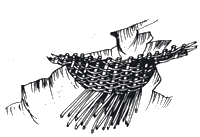1. Find where the gully begins
This is very important. Stop the erosion where it begins. Walk up the gully. Find out the source of the water that flows down the gully during heavy rain. It is very difficult to stop gully erosion just by blocking gullies. So much water may flow down the gully during a storm, that all the barriers may be washed away. First make cut-off drains, contour ditches and grass strips and plant trees to reduce the amount of rainwater that runs into the gully.
2. Encourage your neighbours
Often the water may be coming from land that belongs to other farmers. In a friendly way, explain to these farmers how important it is to control soil erosion. Farmers must work together to stop gullies from growing. Gully control needs community co-operation because a large gully usually passes through several people’s land.
3. Build strong barriers
- Build barriers in the dry season. Use local materials – sticks, branches and rocks. (Very large gullies need wire, cement and special designs, and you will need expert help.)
- Build strong barriers every 4–5 metres. If using sticks, make two rows of strong sticks about 1/2 metre apart in the gully sides and floor. Bang them in at an angle, sloping towards the top of the gully. Put branches or stones between the two rows, pushing them down very firmly.
- Make the centre of the barrier lower than the sides of the gully. Water will then flow over the barrier during a very heavy storm. Otherwise it would flow around the barrier, weakening it.
- Put large, flat stones below the barrier. If water does flow over the barrier, the stones will stop any erosion inside the gully.
- Plant grasses such as vetiver behind the barrier and on the gully sides. Soil will slowly collect behind the barriers. Over several years, the gully will fill up with soil again. Don’t let new gullies begin! Control soil erosion everywhere on your land.
A farmer’s wealth is in the soil. Don’t lose it!










